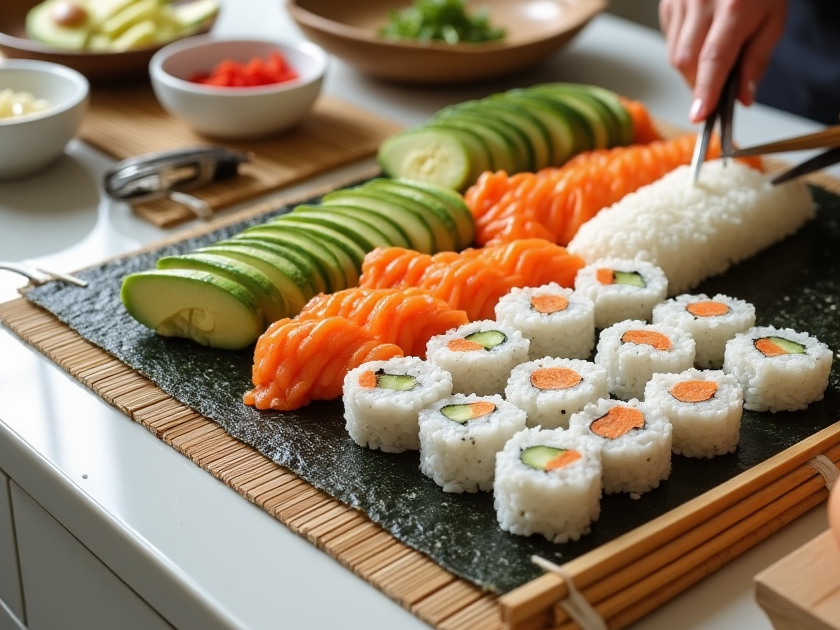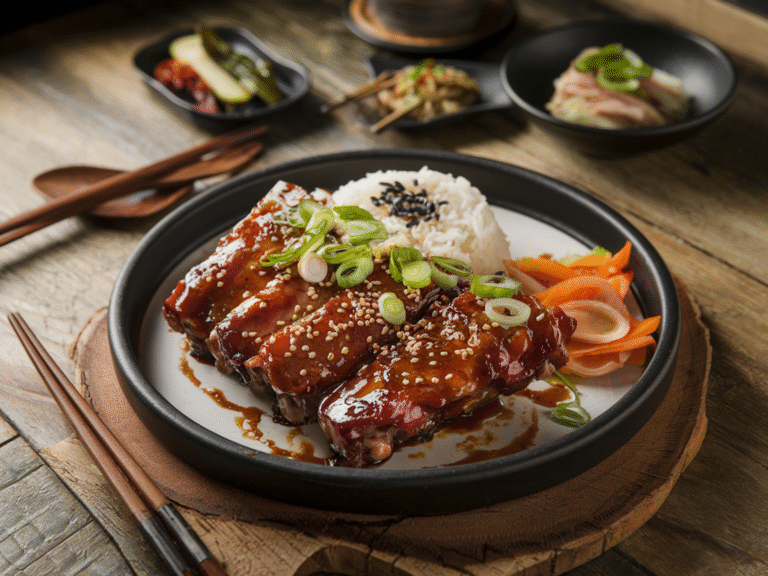Futomaki Sushi Recipe | A Delicious and Easy Homemade Sushi Roll
Futomaki Sushi Recipe: Fresh, Flavorful, and Fun to Make
1. Introduction
Sushi lovers know that sushi isn’t just a meal—it’s an experience. And if you’ve ever tried Futomaki, the thick and hearty sushi rolls, you know just how satisfying and delicious they can be. These rolls are bigger, heartier, and full of flavor, making them perfect for those who love a bit of variety and texture in their sushi.
Why You’ll Love This Recipe
Futomaki is one of the easiest types of sushi to make at home, and it’s a fun activity to share with family or friends. The rolls are packed with fresh vegetables, sometimes a bit of seafood, and wrapped in nori and sushi rice. Whether you’re making sushi for a casual meal or a special occasion, Futomaki will impress everyone with its bold flavors and beautiful presentation. You can customize the fillings to suit your tastes, making this a truly versatile recipe.
In this post, I’ll walk you through the simple steps of making Futomaki Sushi, explain how to prep your ingredients, and share tips for rolling your sushi like a pro. By the end of this post, you’ll have everything you need to make these delicious rolls at home. Let’s get started!
2. Ingredients Breakdown
Futomaki rolls are known for their hearty size and delicious fillings. Here’s a breakdown of what you’ll need to make these rolls:
- Sushi Rice (2 cups):
Sushi rice is short-grain rice that becomes sticky when cooked and is perfect for sushi. The rice is seasoned with a mixture of rice vinegar, sugar, and salt, giving it that signature tangy flavor. Always rinse the rice thoroughly before cooking to remove excess starch and achieve the right texture. - Nori Sheets (5 sheets):
Nori is a type of seaweed used to wrap sushi rolls. For Futomaki, you’ll need full-sized nori sheets. Nori is available at most grocery stores or specialty Asian markets. Be sure to use roasted nori for the best flavor and texture. - Avocado (1 ripe):
Avocado is creamy, slightly sweet, and a great contrast to the crunch of the other ingredients. Slice the avocado into thin strips to easily layer it into your rolls. Make sure to use a ripe avocado for the best texture. - Cucumber (1 medium):
Cucumber provides a refreshing crunch to the sushi rolls. Peel and thinly slice the cucumber lengthwise. You want to remove the seeds for a cleaner texture. It’s a classic vegetable filling that pairs beautifully with the other ingredients. - Carrot (1 medium):
Thin strips of carrot add both color and crunch to the rolls. They’re a simple and healthy addition to Futomaki that balances the creamy avocado and soft rice. Use a julienne peeler or knife to cut the carrot into long, thin strips. - Pickled Radish (optional, 1-2 strips):
Pickled radish (called takuan) is often used in Futomaki for a sweet, tangy contrast to the other ingredients. If you prefer a more neutral flavor, you can omit this or replace it with other pickled vegetables. - Sesame Seeds (1-2 tbsp, optional):
Toasted sesame seeds are often sprinkled on top of Futomaki rolls to add an extra layer of flavor and texture. These seeds are optional but add a nutty crunch that complements the soft rice and vegetables. - Soy Sauce (for dipping):
Soy sauce is a classic accompaniment to sushi. You’ll use it for dipping the sushi and enhancing the flavors. You can also add a bit of wasabi or pickled ginger for extra zing.
Substitutions and Dietary Preferences:
- Vegetarian: Omit any seafood and add more avocado, cucumber, and carrot. You can also add tofu for additional protein.
- Gluten-Free: Ensure that the soy sauce is gluten-free and use gluten-free rice vinegar if needed.
- Dairy-Free: This recipe is naturally dairy-free, but check that your other ingredients (like the rice vinegar) do not contain any dairy products.
3. Step-by-Step Instructions
Making Futomaki is easier than you might think. Just follow these clear and simple steps to make your own sushi rolls:
- Prepare the Sushi Rice:
Rinse sushi rice under cold water until the water runs clear. This removes excess starch and ensures the rice has the right texture for rolling. Cook the rice according to the package instructions. Once cooked, let it cool slightly. In a small bowl, mix rice vinegar, sugar, and salt until dissolved, then stir this mixture into the warm rice. Let the rice cool to room temperature. - Prepare the Fillings:
Slice the avocado, cucumber, and carrot into long, thin strips. If using pickled radish, slice it into long pieces as well. Set all the fillings aside so you’re ready to assemble. - Set Up Your Rolling Station:
Place a bamboo sushi mat on a flat surface. Lay a sheet of nori shiny side down, with the longer side of the nori facing you. Make sure the mat is clean and dry for easy rolling. - Spread the Rice:
Wet your hands with water to prevent the rice from sticking. Take a small amount of sushi rice and spread it evenly over the nori, leaving about 1 inch at the top of the sheet. Press the rice gently to make sure it sticks, but don’t flatten it too much. - Add the Fillings:
In the center of the rice, place a few strips of avocado, cucumber, carrot, and pickled radish (if using). Be careful not to overfill the roll, as this can make it difficult to roll tightly. - Roll the Sushi:
Carefully lift the bamboo mat and nori at the bottom, and roll the sushi tightly towards the top, where you left a bit of nori exposed. Press gently as you roll to ensure the roll stays tight and compact. Once you’ve reached the end, wet the exposed nori with a little water to seal the roll. - Slice the Roll:
Using a sharp knife, slice the roll into 6-8 pieces. Clean the knife between each slice to ensure clean cuts and prevent the rice from sticking. - Serve and Enjoy:
Arrange your Futomaki rolls on a plate, and serve with soy sauce, pickled ginger, and wasabi on the side.
4. Tips and Variations
- For Tighter Rolls: Use a sushi mat and press gently but firmly to make the rolls as tight as possible. The tighter the roll, the better it will hold together when sliced.
- Use Fresh Ingredients: For the best flavor and texture, use fresh fish and ripe avocado. Quality ingredients make all the difference.
- For More Flavor: If you like a bit of heat, add a small dollop of sriracha or spicy mayo to the fillings before rolling.
Variations:
- Vegetarian Futomaki: Replace fish with extra avocado and cucumber or add pickled vegetables for extra flavor.
- Spicy Futomaki: Add spicy tuna or a drizzle of sriracha mayo for a spicy twist.
- Fruit Futomaki: Try adding mango or kiwi for a sweet and refreshing version.
5. Serving Suggestions
Futomaki can be enjoyed on its own, but here are a few ideas for serving it:
- Sides: Serve with a side of miso soup, edamame, or a light seaweed salad to complement the sushi.
- Garnishes: Sprinkle some sesame seeds or scallions on top of your sushi rolls for extra flavor and color.
- Pairing Drinks: Enjoy your Futomaki with a chilled glass of sake or green tea for a complete sushi experience.
6. Storage and Reheating Instructions
- In the Fridge: Sushi is best eaten fresh, but you can store leftover rolls in an airtight container in the fridge for up to 24 hours. The rice will lose some of its freshness, so it’s best to eat it soon after making.
- Freezing Sushi: It’s not recommended to freeze sushi, as the texture of the fish and rice changes significantly once thawed.
Reheating Instructions:
- Sushi should be eaten cold and fresh, so avoid reheating it. If you must, only microwave the fillings lightly, but the rice will lose its texture.
7. Recipe Notes
- Can Be Prepped Ahead of Time: You can prepare the sushi rice and fillings ahead of time. Store the rice in the fridge and assemble the rolls when ready.
- Best with Fresh Nori: Always use fresh, roasted nori for the best flavor and texture. If the nori is stale, it can affect the quality of your sushi rolls.
8. Nutrition Information (Per Serving)
| Nutrient | Amount per Serving |
|---|---|
| Calories | 210 |
| Fat | 9g |
| Saturated Fat | 1g |
| Carbs | 31g |
| Sugar | 6g |
| Fiber | 4g |
| Protein | 5g |
| Sodium | 200mg |
| Cholesterol | 0mg |
| Calcium | 20mg |
| Iron | 1mg |
Nutrition information is an estimate and may vary based on specific ingredients used.
9. Recipe Card Summary
- Course: Main
- Cuisine: Japanese
- Servings: 4
- Prep Time: 30 minutes
- Cook Time: 0 minutes
- Total Time: 30 minutes
Ingredients:
- 2 cups sushi rice
- 5 sheets nori
- 4 oz sushi-grade fish (salmon or tuna)
- 1 ripe avocado
- 1 cucumber
- 1 medium carrot
- 2 tbsp rice vinegar
- 1 tbsp sugar
- ½ tsp salt
Instructions:
- Prepare the sushi rice and let it cool.
- Slice the fish, avocado, and cucumber into strips.
- Lay nori on a bamboo mat and spread with rice.
- Add fish, avocado, and cucumber as fillings.
- Roll tightly and slice into pieces.
- Serve with soy sauce, pickled ginger, and wasabi.
Notes: You can add extra toppings like sesame seeds, tempura flakes, or spicy mayo.
10. Health Benefits
- Sushi Rice: High in fiber and low-fat, sushi rice provides energy without the heaviness of many other carbs.
- Fish: Rich in omega-3 fatty acids, fish like salmon or tuna are great for heart health.
- Avocado: Packed with healthy fats, avocado supports skin health, improves digestion, and provides a rich, creamy texture.
11. Suggested Sauce
Serve your Futomaki with a side of soy sauce, spicy mayo, or a tangy teriyaki sauce for extra flavor. The dipping sauce is essential for bringing out the subtle flavors of the rice and fillings.
12. Avoid These Mistakes
- Overstuffing the Roll: Keep the fillings light to ensure that the roll stays tight and doesn’t fall apart.
- Not Wetting Your Hands: Wet your hands before handling the rice to avoid it sticking to your fingers.
- Not Using Sushi-Grade Fish: Always ensure that your fish is sushi-grade to avoid foodborne illnesses.
13. FAQs
- Can I use cooked fish instead of raw fish?
Yes, you can use cooked shrimp, crab, or even grilled chicken if you prefer not to eat raw fish. - Do I need a sushi mat?
While a bamboo mat makes rolling easier, you can also roll the sushi by hand using a clean towel or just your fingers. - Can I make sushi without fish?
Yes, you can make a vegetarian sushi roll with avocado, cucumber, carrot, and other vegetables. - How do I store leftover sushi?
Store leftover sushi in an airtight container in the fridge for up to 24 hours. - Can I make sushi without rice vinegar?
Rice vinegar is essential for seasoning the sushi rice. If you don’t have it, you can substitute with a little lemon juice or apple cider vinegar. - How do I keep the sushi from being too sticky?
Wet your hands when handling the rice, and avoid pressing it down too hard when spreading it on the nori.
14. Final Thoughts
Making Futomaki at home is an enjoyable and rewarding experience. With fresh ingredients and a little practice, you can create delicious rolls that rival your favorite sushi restaurants. I hope this recipe helps you master the art of sushi rolling—let me know how it turns out in the comments below! Happy cooking!









